By Walter Galan • Difficulty: Moderate
Learn how to replace your iPhone 6 screen. This part comes with the front-facing camera, earpiece speaker and LCD shield plate already installed, making for an easier repair.
All you need to do is remove the old screen and transfer the home button to the new screen.
You can also use this guide to replace the front panel assembly cable bracket.
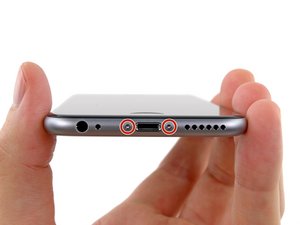
- Power off your iPhone before beginning disassembly.
- Remove the two 3.6 mm-long P2 Pentalobe screws next to the Lightning connector.



- If your display glass is cracked, keep further breakage contained and prevent bodily harm during your repair by taping over the glass.
- Lay overlapping strips of clear packing tape over the iPhone's display until the whole face is covered.
- If the broken glass makes it difficult to get a suction cup to stick in the next few steps, try folding a strong piece of tape (such as duct tape) into a handle and lifting the display with that instead.



- Pull the blue handle backwards to unlock the Anti-Clamp's arms.
- Slide the arms over either the left or right edge of your iPhone.
- Position the suction cups near the bottom edge of the iPhone just above the home button—one on the front, and one on the back.
- Squeeze the cups together to apply suction to the desired area.



- Pull the blue handle forwards to lock the arms.
- Turn the handle clockwise 360 degrees or until the cups start to stretch.
- Insert an opening pick under the screen when the Anti-Clamp creates a large enough gap.
- Skip the next three steps.

- If you don't have an Anti-Clamp, use a single suction cup to lift the front panel:
- Press a suction cup onto the screen, just above the home button.

- While holding the iPhone down with one hand, pull up on the suction cup to slightly separate the front panel assembly from the rear case.
- Using a plastic opening tool, begin to gently pry the rear case down, away from the display assembly, while continuing to pull up with the suction cup.


- Pull the plastic nub to release the vacuum seal on the suction cup.
- Remove the suction cup from the display assembly.



- Open the iPhone by swinging the home button end of the front panel assembly away from the rear case, using the top of the phone as a hinge.



- Open the display to about a 90º angle, and lean it against something to keep it propped up while you're working on the phone.
- Add a rubber band to keep the display securely in place while you work. This prevents undue strain on the display cables.
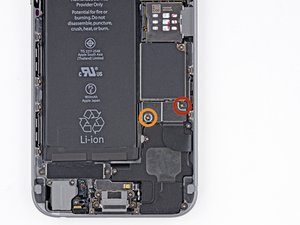
- Remove the following Phillips screws from the battery connector bracket:
- One 2.2 mm screw
- One 3.2 mm screw

- Remove the metal battery connector bracket from the iPhone.

- Use a plastic opening tool to gently pry the battery connector up from its socket on the logic board.
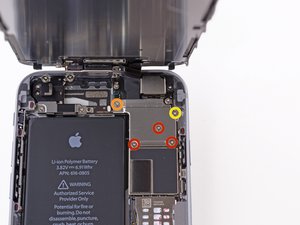
- Remove the following five Phillips screws securing the front panel assembly cable bracket:
- Three 1.2 mm screws
- One 1.7 mm screw
- One 3.1 mm screw

- Remove the front panel assembly cable bracket from the logic board.
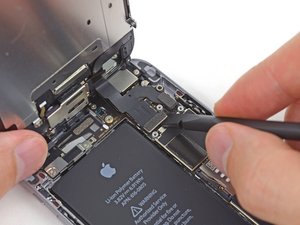

- Use a spudger or a fingernail to disconnect the front-facing camera and sensor cable connector.
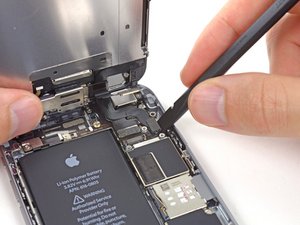

- Use a spudger or a fingernail to disconnect the home button cable connector.


- Use a spudger or a fingernail to disconnect the display data cable connector.
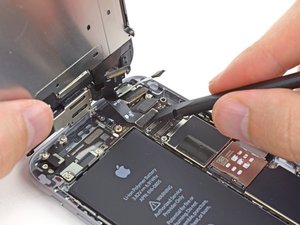

- Use the flat end of a spudger to disconnect the digitizer cable connector.

- Remove the front panel assembly from the rear case.
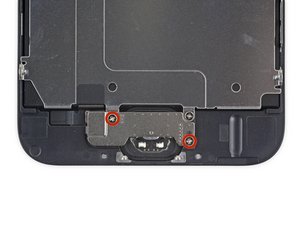
- Remove the two 1.9 mm Phillips screws securing the home button bracket.


- Remove the home button bracket from the front panel.


- Use the point of a spudger to disconnect the home button cable connector by pushing it up and away from the home button.


- Apply mild heat (with an iOpener, heat gun, or hair dryer) to soften the adhesive securing the home button membrane.
- Using your fingertip, apply firm, constant pressure on the home button from the front side of the display assembly, until the membrane starts to separate from the front panel.


- Peel the home button the rest of the way off of the display by prying gently with a spudger.


- Use the point of a spudger to carefully separate the home button cable from the adhesive securing it to the front panel.

- Once all the adhesive has been separated, remove the home button from the front panel.
To reassemble your device, follow these instructions in reverse order.